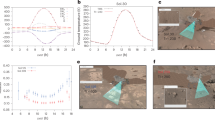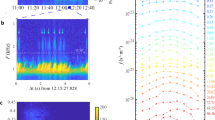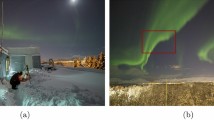Abstract
ALMOST all investigations of high-frequency and very high-frequency reflexions from aurora made in or near the auroral zone have given diurnal variation curves with one main maximum near local midnight1–3. An exception is the recent observations by Presnell et al. 4 at 216 Mc./s., made at College, which—for diffuse echoes only—has given two maxima, one in the morning and one in the afternoon with the peak between 1700 and 1900 L.T. Observers at lower latitudes have usually found two maxima in the night5–8.
This is a preview of subscription content, access via your institution
Access options
Subscribe to this journal
Receive 51 print issues and online access
$199.00 per year
only $3.90 per issue
Buy this article
- Purchase on SpringerLink
- Instant access to full article PDF
Prices may be subject to local taxes which are calculated during checkout
Similar content being viewed by others
References
Hellgren, G., and Meos, J., Tellus, 3, 249 (1952).
Bowles, K. L., Dyce, R. B., and Little, C. G., Final Report Task E. Signal Corps Contract No. DA-36-039-SC-56739, Geophysical Institute, College, Alaska (1955).
Currie, B. W., Forsyth, P. A., and Vawter, F. E., J. Geophys. Res., 58, 179 (1953).
Presnell, R. I., Leadabrand, R. L., Peterson, A. M., Dyce, R. B., Schlobohm, J. C., and Berg, M. R., J. Geophys. Res., 64, 1179 (1959).
Boullough, K., and Kaiser, T. R., J. Atm. Terr. Phys., 6, 198 (1955).
Dyce, R., Trans. Inst. Rad. Eng., PGAP-3, 2, 76 (1955).
Gerson, N. C., Proc. Phys. Soc., 68, B, 408 (1955).
Unwin, R. S., Ann. Géophys., 15, 377 (1959).
Author information
Authors and Affiliations
Rights and permissions
About this article
Cite this article
EGELAND, A., HULTQVIST, B. & ORTNER, J. A Day-time Maximum of Oblique Auroral Reflexions observed in the Auroral Zone. Nature 185, 519 (1960). https://doi.org/10.1038/185519a0
Issue date:
DOI: https://doi.org/10.1038/185519a0
This article is cited by
-
Radio aurora
Space Science Reviews (1964)



